The PFF50 is finally here. After listing the best 101 NFL players from the 2018 season, we at PFF have put together a list of the 50 best players as we look ahead to the 2019 NFL season — the 50 best players in the game right now.
The PFF50 is a product of evaluating every player on every play of each NFL season to produce PFF's unrivaled database of stats, grades and information. This list is not about how valuable players are, but about how good they are, regardless of position.
We started from the standpoint of a multi-year look at their grading before making adjustments based on situation, injuries where relevant, and new circumstances that could change a player's future outlook.
All 50 of the players and their respective ranks will be revealed on Twitter, YouTube and, of course, this article! Nos. 50-31 will be announced Monday, Nos. 30-21 Tuesday, Nos. 20-11 Wednesday and Nos. 10-1 on Thursday.
[Editor's Note: All of PFF's advanced stats and grades for every NFL player dating back to 2006 are made available to ELITE subscribers. Sign up for free today!]
50. G Shaq Mason, New England Patriots
Mason has quietly developed into one of the NFL’s top guards now just four years removed from going in the fourth round to the Pats in the 2015 NFL Draft. He has earned 75.0 or higher run-blocking grades every year of his career thus far, all while playing 300 or more run-blocking snaps each season dating back to his rookie campaign.
He did need time to develop as a pass blocker having played in Georgia Tech’s triple option at the collegiate level, but Mason seemingly put it all together in 2018. He earned career-high marks in pass-blocking grade (80.2) and overall grade (85.0) across his 1,202 offensive snaps this past season, and he also logged his third consecutive season with an 80.6 run-blocking grade. Not only did his impact run-block percentage (15.0%) lead all guards, but he also ranked tied for sixth in PFF’s pass-blocking efficiency metric (98.3) and tied for eighth in pressure percentage allowed (3.2%).
49. DI Damon Harrison, Detroit Lions
Snacks continued his reign over the NFL as the league’s top run defender across what was a 17-game season for the seven-year veteran having played seven games with the New York Giants and another 10 with the Lions post-trade. He earned a 92.0 overall grade and a 93.8 run-defense grade across his 606 defensive snaps split between the two teams, ranking third and first, respectively, among qualifiers at his position. He’s now earned an 89.9-plus overall grade and a 91.6-plus run-defense grade in four of his last five seasons in the league – utter dominance, if you will.
From PFF's Josh Liskiewitz:
“Trading for Harrison before the in-season deadline proved a brilliant move for the Lions this year, and considering his consistent track record of complete dominance against the run; the move should continue to pay dividends in 2019 and beyond.”
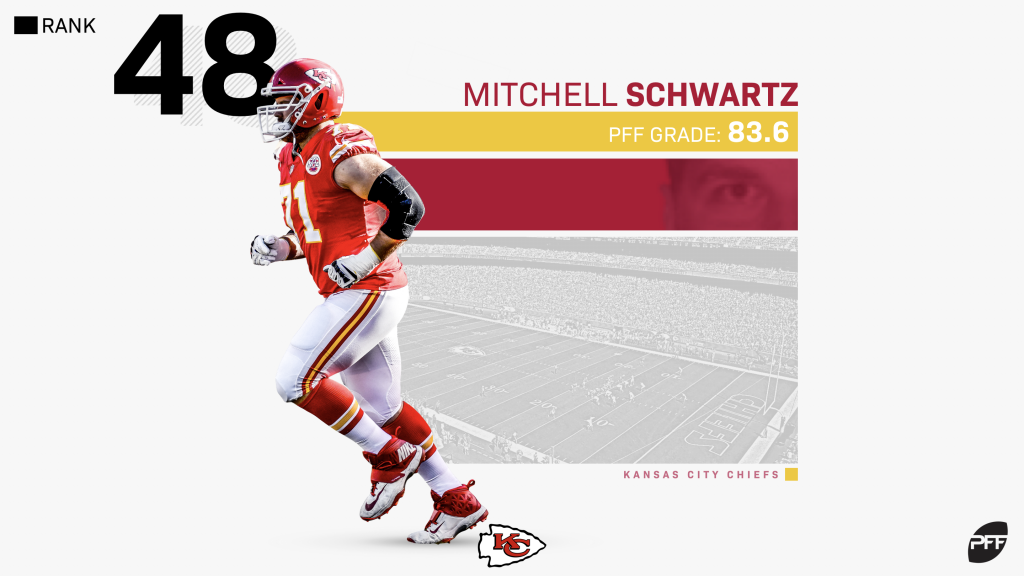
48. T Mitchell Schwartz, Kansas City Chiefs
Schwartz turned in career-highs in overall grade (83.6) and pass-block grade (85.6) this past season. He also finished the year ranked tied for fifth in pass-blocking efficiency (97.9) and pressure percentage allowed (3.6%). The epitome of consistency, Schwartz has played 1,000 or more offensive snaps in every year of his seven-year NFL career and has yet to earn an overall grade below 72.6 or a pass-blocking grade below 73.8.
47. S Eddie Jackson, Chicago Bears
After earning just a 68.3 overall grade across 1,055 defensive snaps as a rookie, Jackson exploded onto the NFL scene in Year 2 of his career. He logged five defensive touchdowns and earned position-high marks in overall grade (93.2) and coverage grade (94.7) in the process. Regression is in order for the former Alabama standout given just how successful he was in creating turnovers and turning them into points, but he shouldn’t fall far in 2019.
46. Edge Trey Flowers, Detroit Lions
Even though Bill Belichick & Co. were reluctant to pay him his due to stay in New England, Flowers is still a premier talent in this league and should very well live up to the expectations tied to his new five-year, $90 million deal with the Lions.
Improving steadily every year of his career, Flowers earned career-high marks in overall grade (89.7), run-defense grade (84.9) and pass-rush grade (79.9) a year ago. He also finished the 2018 season ranked tied for eighth in pass-rush win percentage (17.4%) and sixth in pressure percentage among the 61 NFL edge defenders with 300 or more pass-rush snaps played.
From PFF's Austin Gayle on Flowers pre-free agency:
“Flowers eats away at his good-not-great pass-rushing ability with his run defense and versatility, specifically his ability to rush the passer from ranging pre-snap alignments as mentioned above. He’s a movable chess piece with consistent, high-end play in several areas over the years, a piece that teams should and will jump to move into their system if given the opportunity this offseason.”
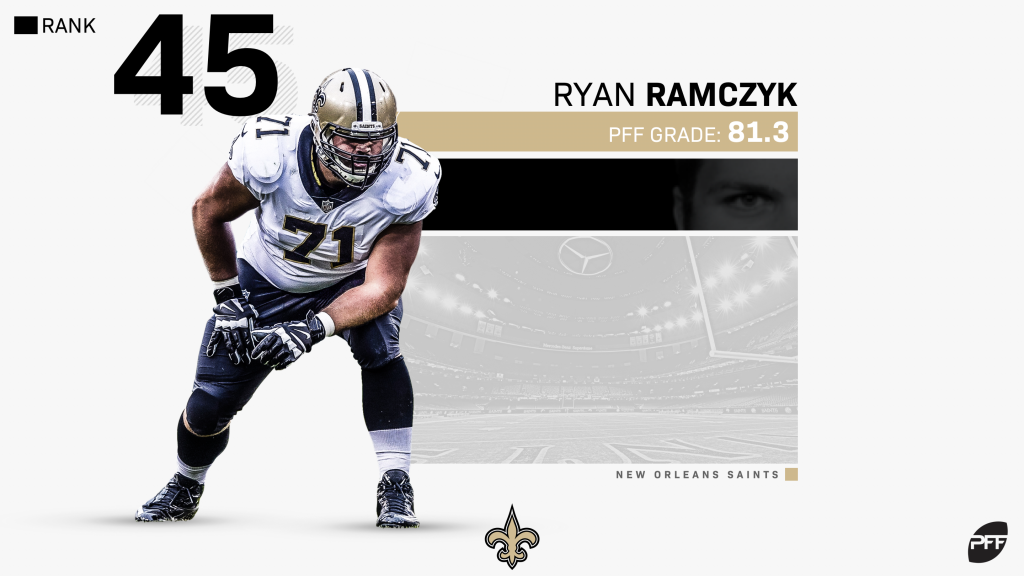
45. T Ryan Ramczyk, New Orleans Saints
New Orleans’ brass has seemingly hit a home run with 2017 first-round pick Ryan Ramczyk, as the former Wisconsin product has been nothing but outstanding in his two years in the NFL. Ramczyk has earned 81.0-plus overall grades in each of his first two seasons in the NFL, all while playing at least 1,000 offensive snaps each year. He’s also earned 76.0-plus pass-blocking grades and 77.0-plus run-blocking grades in each of the two seasons.
Also driving our confidence in Ramczyk being the 45th-best player in the NFL right now is just how successful he was at the collegiate level. Before earning high marks with the Saints, Ramczyk earned a 92.3 overall grade, an 84.7 pass-block grade and a 91.4 run-block grade.
44. CB Desmond King II, Los Angeles Chargers
Like Ramczyk, King entered the NFL with outstanding collegiate production. He earned 85.0-plus coverage grades in each of his last three seasons with Iowa, including a career-high 89.9 coverage grade in 2016.
And we’ve only seen much of the same from King at the NFL level. In his two years with the Bolts, King has earned 85.7-plus overall grades and 86.6-plus coverage grades. Also, his two-year slot coverage grade (92.0) leads all qualifying slot cornerbacks. Now just 24 years old heading into Year 3 in the league, King is well on his way to becoming the NFL’s next great slot cornerback – a position growing in value year after year.
43. RB Saquon Barkley, New York Giants
We’ve already seen enough from Barkley to slot him at No. 43 on this list. His 85.9 overall grade, 84.6 rushing grade and 86.4 receiving grade all rank inside the top-five among qualifying rookie running backs in the PFF era (2006-18). Looking specifically at his pass-catching ability, Barkley caught more passes (91), gained more yards after the catch (787) and forced more missed tackles on receptions than any rookie running back since 2006.
And all signs point to Barkley being much more than a one-year wonder. He earned 81.0-plus overall grades in all three years at Penn State (2015-17) and logged 80.0-plus receiving grade in his last two collegiate seasons.
42. S Kevin Byard, Tennessee Titans
In junior and senior seasons at Middle Tennessee (2014-15), Byard earned 81.0-plus overall grades and 86.0-plus coverage grades. And his collegiate success has only followed him to the NFL ranks.
After somewhat of a slow start as a rookie (68.5 overall grade), Byard turned in 85.3 and 88.4 overall grades in 2017 and 2018, respectively. All combining for what was a career year for Byard, he earned an 89.0 run-defense grade, an 82.5 coverage grade and allowed a lowly 55.8 passer rating in coverage in 2018, logging four picks and two passes defensed in the process. Slotted as one of the better single-high safety prospects in the 2016 class, Byard has truly thrived at the position with Tennessee.
41. Edge Brandon Graham, Philadelphia Eagles
Sacks don’t tell the whole story for any player in the NFL, and no player epitomizes that more than Graham. He’s only recorded double-digit sacks in PFF’s system once (2017) but has been as consistent as they come from an overall pressure and pass-rush grade standpoint. He has recorded 45 or more pressures in six of his last seven seasons in the NFL and has earned 81.0-plus pass-rush grades in five of them.
40. G Zack Martin, Dallas Cowboys
Martin’s pass-blocking prowess has been among the league’s best over the course of his five-year NFL career. He has earned 84.1 pass-blocking grades each and every season and his 92.7 career pass-blocking grade ranks fourth among the 54 NFL guards with 1,500 or more pass-blocking snaps played in the last five years.
Though his run-blocking grade fell to a career-low 70.0 mark in 2018, he has shown in previous years that it’s far from his standard of play. He earned 82.0-plus run-blocking grades in the three years prior to the 2018 season, and his career run-blocking grade (91.2) ranks second only to the great Marshal Yanda (93.7) since 2014.

39. QB Russell Wilson, Seattle Seahawks
Wilson has ranked inside the top-10 in overall grade among qualifying quarterbacks in six of his seven years in the NFL, and he only dropped to 14th in the only season he ranked outside the top-10 (2014). His passing grade and passer rating from a clean pocket – two very stable metrics year over year – have both ranked inside the top-10 in each of the past two seasons, and he’s ranked inside the top-10 in at least one of the two metrics in every season but his 2016 campaign.
PFF’s NFL Editor Mark Chichester said it best in his article on the superstar quarterback prior to his new contract getting signed:
“Wilson is not inconsistent. He is not easily replaced with a second-string quarterback. He’s shown no signs of being past his prime, and he’s certainly not worth trading away for merely a couple of first-round draft picks. Wilson is — and has been for some time — one of the league’s best at the position; he should be Seattle’s number one priority.”
38. S Derwin James, Los Angeles Chargers
Like Barkley, James only needed one season in the NFL to prove he’s worth a spot on the 2019 PFF50. The do-it-all Chargers safety could do no wrong as a rookie, earning high grades against the run, in coverage and rushing the passer all from an array of pre-snap alignments. His 88.3 overall grade a year ago ranks third among all qualifying rookie Safeties in the PFF era (2006-18), which made him a no-brainer decision for PFF Defensive Rookie of the Year honors in 2018.
From PFF’s Cam Mellor on James:
“Described as a ‘movable chess piece’ along the defense, James’ ability to line up across the field, and do so efficiently, led to his selection as our Defensive Rookie of the Year as well as his ridiculous statistics in our PFF advanced metrics.”
37. DI Kenny Clark, Green Bay Packers
After earning an 87.8 overall grade and an 89.1 run-defense grade in his sophomore season in the NFL, Clark took a significant Year 3 leap as a pass-rusher. He went from 67.9 and 69.6 pass-rush grades in 2016 and 2017, respectively, to an astounding 88.8 pass-rush grade in 2018. He also finished the year ranked 11th in pass-rush win percentage (14.1%) and ninth in total pressure percentage (12.0%). Originally knocked for his undersized frame and short arms, Clark has risen above such critiques and now stands tall as one of the best defensive interiors in the NFL.
36. RB Alvin Kamara, New Orleans Saints
Turning in 91.3 and 89.4 receiving grades in Years 1 and 2 of his NFL career, Kamara has truly redefined the running back position. In addition to his elusiveness and overall efficiency on the ground, Kamara adds so much value in the passing game. He leads all NFL backs with at least 50 targets over the past two years in yards per route run (2.37), yards after the catch (1,528), yards after contact on receptions (593), forced missed tackles on receptions (46) and receptions of 15-plus yards (39).
35. Edge Myles Garrett, Cleveland Browns
No first- or second-year edge defender has a higher ceiling than Garrett right now. His two-year pass-rush grade (88.0) ranks eighth, and his 18.4% pass-rush win rate ranks seventh among the 56 NFL edge defenders with 600 or more pass-rush snaps since 2017.
Garrett’s rare size and athleticism made him a monster at the collegiate level. He earned 90.0-plus pass-rush grades in each of his three seasons at Texas A&M, logging 46 or more pressures every year, as well. The shackles are off for Garrett in Year 3 with Gregg Williams no longer keeping him from using all the tools in his toolbox as a pass-rusher, making it all the more likely he finishes higher on this list in 2020.
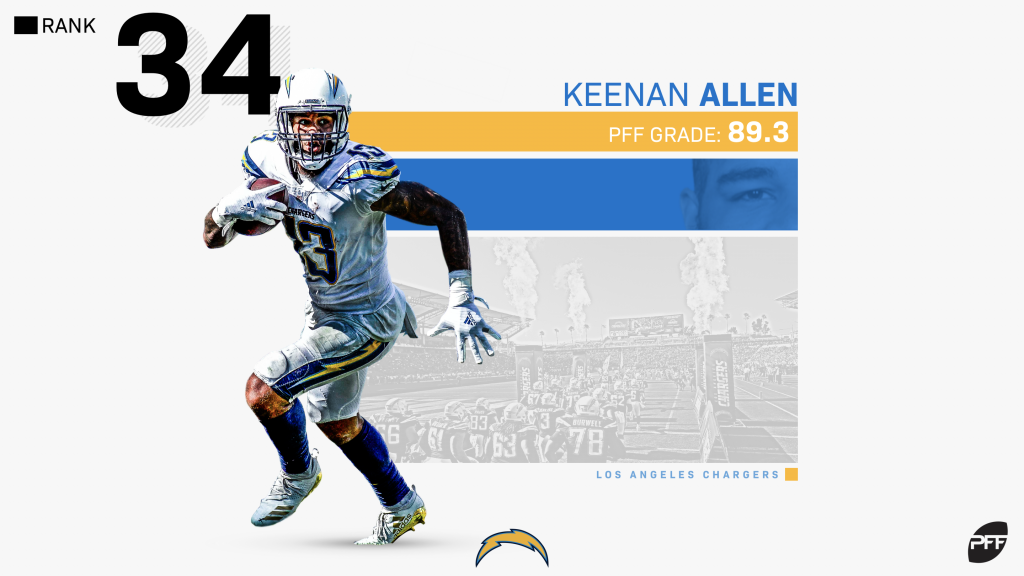
34. WR Keenan Allen, Los Angeles Chargers
Allen’s two-year receiving grade (91.2) ranks fourth among the 53 NFL wideouts with 150 or more targets since 2017. Only Michael Thomas, DeAndre Hopkins and Julio Jones rank ahead of the Chargers phenom. He also ranks third in yards per route run (2.43) and seventh in passer rating when targeted (111.6) among the same group of qualifiers.
From PFF's Cam Mellor in his WR prototypes article released last week:
“An underrated aspect of Allen’s repertoire, his route-running skills are second to none at this stage of his career. Not only does he have a feel for coverages, but he also has an innate knack for reading when and where to make his breaks based upon the defenders he’s going to face. He’s just as routinely spotted jetting past overwhelmed linebackers as he is finding the soft spots in zone coverage in between defensive backs.”
33. Edge JJ Watt, Houston Texans
After injuries limited him to fewer than 250 defensive snaps in 2016 and 2017, Watt played 1,000-plus snaps for the first time since 2015 this past season. And while the results didn't mirror his four-year (2012-15) dominance that made him a household name, Watt still earned an impressive 90.6 overall grade, an 88.7 run-defense grade and an 89.7 pass-rush grade on the year.
Watt's efforts landed him the No. 19 spot on PFF's list of the top 101 players from the 2018 season:
“Watt was back to his utterly dominant self this year. He was once again named a PFF All-Pro, and his 78 pressures were the second-most among edge defenders. Watt ended the 2018 regular season with at least three quarterback pressures in 14 straight games, which is the longest active streak by four games.”
32. Edge Demarcus Lawrence, Dallas Cowboys
Lawrence had a slow start to his career. The 2014 second-round pick earned sub-72.0 pass-rush grades in each of his first three seasons in the NFL before exploding in Year 4 (2017). He earned an impressive 91.6 overall grade and an even better 92.0 pass-rush grade in what was a contract year for the rising star.
Before committing to Lawrence long-term after just one breakout year, Dallas’ brass asked him to prove it via the franchise tag. He played on the tag in 2018 and very much proved himself, earning an 88.0 overall grade and an 82.7 pass-rush grade on the year. Now, his two-year pass-rush grade (91.4) and two-year pass-rush win rate (19.4%) ranks fifth among the 60 NFL edge defenders with 500 or more pass-rush snaps since 2017.
31. LB Deion Jones, Atlanta Falcons
Jones’ breakout season in 2017 was truly spectacular. The 2016 second-round pick turned in an elite 91.7 coverage grade across 719 coverage snaps in his sophomore season in the NFL, a single-season mark that ranks first among the 88 off-ball linebackers with 300 or more coverage snaps as second-year players in the PFF era (2006-18).
Injuries kept us from seeing Jones build on his impressive 2017 season, but we at PFF are confident he can return to form when healthy and should be valued as one of the NFL's top off-ball linebackers.
From PFF's Austin Gayle on why Atlanta should jump at extending Jones early:
“Jones didn’t quite return to form when he came back from injury in Weeks 13-17, but that shouldn’t keep the Falcons’ brass from banking on him bouncing back. He’s proved he can excel in coverage across a significant sample size, a sought-after but a rarely found trait in off-ball linebackers. The injury combined with the timing of the contract extension could very well have Atlanta rostering the league’s best coverage linebacker on a bargain.”
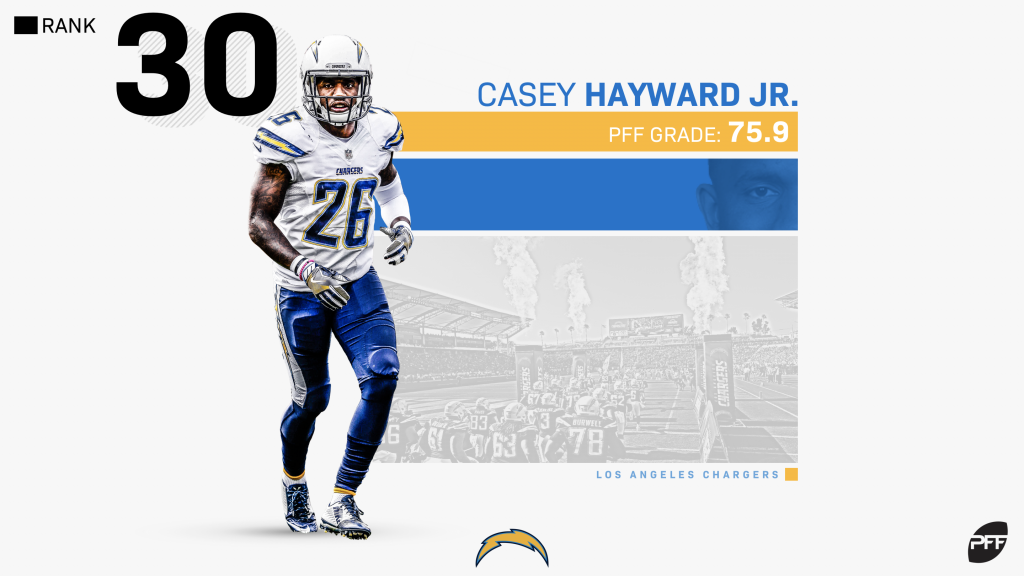
30. CB Casey Hayward Jr., Los Angeles Chargers
No NFL cornerback has earned a higher coverage grade over the last three seasons than Hayward (91.9). Since joining the Bolts in 2016, Hayward has allowed just 125 receptions from 236 targets for 1,782 yards, 80 first downs and nine touchdowns, while he's also logged 56 forced incompletions —the third-most of any cornerback in that period. Among the 111 cornerbacks targeted 100 or more times since 2016, Hayward ranks third in forced incompletion percentage (23.7%), ninth in passer rating allowed (71.0) and eighth in completion percentage allowed (53.0%).
29. C Travis Frederick, Dallas Cowboys
Prior to spending the entire 2018 season on the injured reserve list with Guillain-Barré syndrome, Frederick sat atop the NFL as the league’s top center. He played 1,000 or more offensive snaps in each of his first five years in the league and earned 85.0-plus overall grades every year. Only former Houston Texans center Chris Myers and Frederick have at least five single-season overall grades above 85.0 across 600-plus offensive snaps in the PFF era (2006-18).
28. TE Travis Kelce, Kansas City Chiefs
Among the 63 NFL tight ends with at least 900 offensive snaps played in the last three seasons, Kelce ranks first in overall grade (91.1) and receiving grade (91.1). He also leads all tight ends in receptions of 15-plus yards (104), yards after the catch (1,774) and first-down receptions (189).
Kelce’s ability to force missed tackles and gain yards after the catch is truly what makes him special. His three-year forced missed tackles total (38) leads all tight ends, and his staggering 6.1 yards after the catch per reception average since 2016 is absurd considering the fact that he’s hauled in 290 receptions in the three-year span.
27. DI Kawann Short, Carolina Panthers
From PFF’s Austin Gayle in his latest on Short:
“Only Aaron Donald, Damon Harrison Sr. and Fletcher Cox have earned higher overall grades inside the tackles than Carolina Panthers’ Kawann Short (92.1) over the past three seasons. Only Donald and Harrison have earned higher run-defense grades than Short (92.2) from such pre-snap alignments, and Short’s 85.2 three-year pass-rush grade inside the tackles ranks seventh among qualifiers.”
Short is right behind Donald, Cox and Kansas City Chiefs’ Chris Jones in what has become a four-man race for top interior defensive linemen in the NFL. Though he’s coming off a bit of a down year from a pass-rushing perspective, Short is still one of the league’s feared interior pass-rushers and as consistent as they come in the run game.
26. Edge Calais Campbell, Jacksonville Jaguars
Campbell has earned an 85.0-plus run-defense grade in each of the past five seasons, all while playing at least 300 run-defense snaps every year. Most recently, he turned in a career-high 93.8 run-defense grade with Jacksonville in 2018, which was good for league-best among qualifying edge defenders.
Though Campbell’s pass-rush grades have fallen off since his career-best 89.2 pass-rush grade in 2016, he’s still proved more than capable of terrorizing quarterbacks in his own right. He’s still kept his pass-rush grade above 70.0 in each of the past three seasons, and he’s recorded at least 50 total pressures in five of the last six campaigns.
From PFF’s Mike Johnson on Campbell’s epic 2018 season:
“Over the latter stages of his 11-year NFL career, Campbell has blossomed into one of the very best players at his position, notably finishing among the top three in overall grade among his peers in each of the last three seasons. The Jaguars made the no-brainer decision to exercise their 2019 team option for Campbell in February, with plans of a contract extension in the future. Barring injury, expect more elite-level outings from Campbell next season with the likely possibility of one being the best performance at the edge position once again.”
25. QB Andrew Luck, Indianapolis Colts
In Weeks 7-17 of last year, Luck earned the fourth-best overall grade of any offensive player in football at 91.4. He proved his ailing shoulder issues were no longer a concern and was rightfully named the AP and PFF Comeback Player of the Year as a result.
From PFF’s Ben Linsey on Luck and his PFF Comeback Player of the Year honors:
“He finished the season ranked third among all quarterbacks in PFF grade at 91.1 behind only Patrick Mahomes and Drew Brees. If it weren’t for the brilliance of those two, his name would be soundly in the MVP conversation. After that 1-5 start, the Colts only lost one more game the rest of the season, and it was due largely to Luck showing that the shoulder issues that plagued him for over a year were in the rear-view mirror and he was still in the elite tier of quarterbacks.”
For the first time in his career, Luck was at the helm of an offense designed to make him better rather than have him lean on the surrounding talent, and it resulted in him receiving a career-high overall grade (91.2) in 2018. The sky’s the limit for Luck heading into Year 2 under Frank Reich.
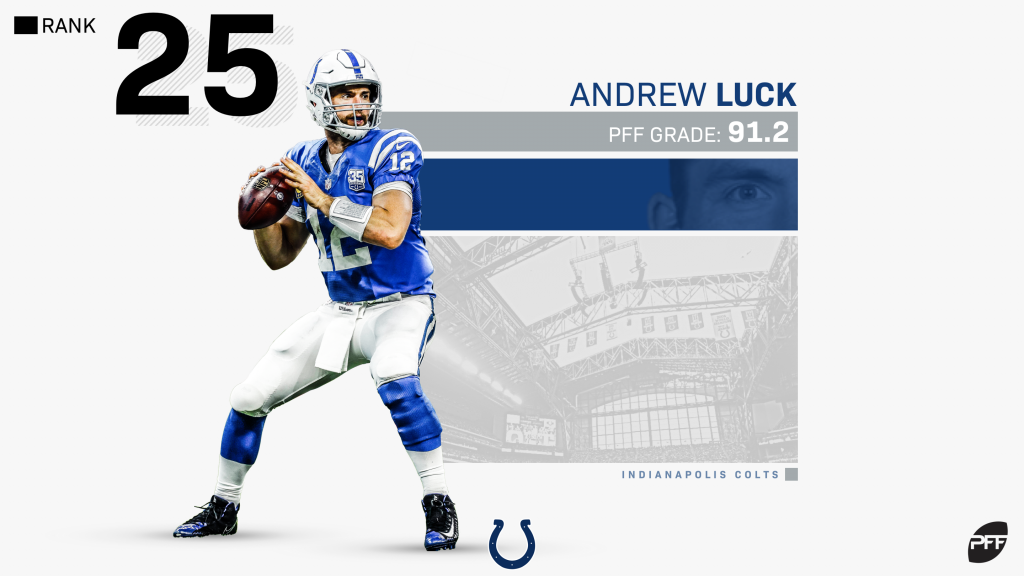
24. C Jason Kelce, Philadelphia Eagles
Kelce’s four-year overall grade (91.1) ranks fourth among the 94 interior offensive linemen with at least 2,000 offensive snaps played since 2015, and his 93.4 run-block grade ranks first among the same group of qualifiers. Most recently, Kelce earned a career-high 88.0 pass-blocking grade in addition to his 80.7 run-blocking grade in 2018. He also earned a 94.6 run-blocking grade throughout the Eagles’ Super Bowl run in 2017, a single-season mark that ranks first in the PFF era (2006-18) among qualifying centers and one that landed him PFF’s top run-blocker award in 2017.
From PFF’s Mike Renner following Kelce’s stellar 2017 campaign:
“A combination of Pederson scheming more to Kelce’s strengths and Kelce getting stronger flipped the All-Pro switch once again inside the Eagles center. He’s been dominant in the run game, from the first snap to the last, with only one sub-par graded game all season.”
23. CB Chris Harris Jr., Denver Broncos
From PFF’s Mark Chichester on Harris Jr. and his incredible NFL career:
“Whichever way you slice it, Harris has been among the very best at his position over his eight years in the NFL. He’s graded in the top 10 among corners in five of his eight seasons, and he notably finished the 2016 season with an elite 90.2 overall grade that ranked first among his peers. Over his entire career, the former Kansas Jayhawk has allowed 377 catches from 644 targets for 3851 yards, 16 touchdowns and 19 interceptions, and among the 59 cornerbacks who have seen at least 500 career targets within the PFF era (2006 – present), Harris’ 71.8 passer rating allowed ranks sixth, his 10.2 yards allowed per reception ranks first, his 0.87 yards allowed per coverage snap ranks second and his 11.73 snaps played per reception allowed ranks 12th.”
Asked to play outside cornerback in Denver’s base defense and slot cornerback in nickel and dime packages, Harris is in a league of his own both from a positional versatility and overall production standpoint. The Broncos’ brass was smart to increase Harris’ pay this offseason; his consistent, high-end play is hard to find in the secondary.
22. WR Antonio Brown, Oakland Raiders
Brown earned a career-low 79.0 receiving grade in 2018, and he still caught 104-of-164 targets for 1,297 yards and 15 touchdowns on the year. That alone speaks volumes to just how productive Brown has been all throughout his career. Among the 66 wide receivers with 300 or more targets in the last five seasons, Brown ranks second in overall grade (93.9), yards per route run (2.53) and total receptions of 15-plus yards (209). Only Atlanta Falcons’ Julio Jones ranks higher in the three metrics.
21. S Harrison Smith, Minnesota Vikings
Among the 70 NFL safeties with 2,000-plus defensive snaps played in the last five years (2014-18), only Earl Thomas (93.6) has earned a higher overall grade than Smith (92.6). The Vikings standout also ranks first in run-defense grade (96.4) and fourth in coverage grade (93.6) among the same group of qualifiers.
From PFF’s Sam Monson when Harrison was awarded PFF’s Dwight Stephenson Award for best player in the NFL in 2017:
“When you turn on the tape, you see a player at the heart of every meaningful play on the best defense in the NFL, and somebody that was far more influential than any other safety during the 2017 season.
Because he is a safety, Smith stands no chance of garnering any kind of MVP recognition, but if you look purely at the best players in the game this season, there is little doubt that he was one of the best in the game, and in PFF’s opinion, the best in the entire league.”
20. DI Chris Jones, Kansas City Chiefs
Jones’ three-year overall grade (90.8) and pass-rush grade (91.1) rank sixth and tied for third, respectively, among the 73 at his position with 1,200 or more defensive snaps played since 2016. He also ranks fourth among qualifiers in three-year pass-rush win percentage (15.7%) behind Aaron Donald, Fletcher Cox and Geno Atkins.
From PFF’s Austin Gayle on his latest feature on Jones:
“Compare Jones’ 2018 campaign to other third-year interior defensive linemen in the PFF era, and the numbers only become more impressive. Only Donald (93.3) and Atkins (92.8) earned higher pass-rush grades as third-year players than Jones did this past year. And while Donald’s 21.4% pass-rush win percentage in 2016 takes the cake among third-year defensive interiors, Jones’ 19.6% this past season ranks second.”
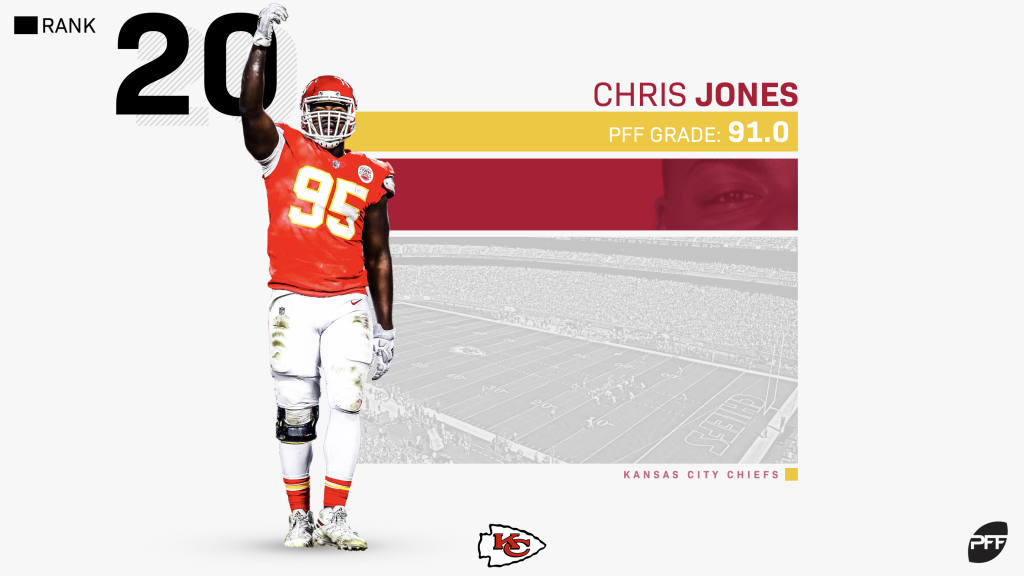
19. WR Odell Beckham Jr., Cleveland Browns
Despite having to battle inconsistent play at the quarterback position throughout the entirety of his career, OBJ has still managed to take the league by storm since coming off the board at No. 12 overall in 2014. His five-year receiving grade (92.6) ranks sixth among the 47 wideouts with at least 2,000 routes run in the last five years. Only Julio Jones, Antonio Brown and DeAndre Hopkins rank ahead of the former LSU standout in receiving grade and yards per route run on the list.
Trading an aging Eli Manning for second-year Baker Mayfield in Cleveland, Beckham has a real shot at earning career-high marks across the board and jumping ahead some of the aforementioned wideouts in 2019.
18. S Earl Thomas III, Baltimore Ravens
Thomas led all qualifying safeties in overall grade (91.3) and coverage grade (90.6) before he suffered a season-ending injury (lower leg fracture) in Week 4 of last season. He showed he can still play at an elite level nine years into his NFL career and should only pick up where he left off in Baltimore if he can stay healthy.
Among the 70 NFL safeties with at least 2,000 snaps played in the last five years, Thomas ranks first in overall grade (93.6) and coverage grade (97.2). He’s one of the very few free safeties who have dominated as a standalone centerfielder in the NFL, a rare talent by all measures.
17. QB Aaron Rodgers, Green Bay Packers
Rodgers, though hampered by injury throughout the season, still finished the year with an impressive 89.7 overall grade that ranked fifth among qualifying signal-callers in 2018. He also ranked seventh in clean-pocket passing grade (90.7) and ninth in passer rating from a clean pocket (109.0).
Though his 5.86% big-time throw rate cracked the top-five among quarterbacks with 300 or more dropbacks last season, it was Rodgers’ ability to avoid turnover-worthy plays that truly propped his overall and passing grades up in 2018. He committed a turnover-worthy play on an NFL-low 1.04% of his dropbacks on the year.
16. Edge Cameron Jordan, New Orleans Saints
With the league’s flashy (i.e., Khalil Mack, Demarcus Lawrence, Von Miller) edge defenders stealing the limelight, Jordan has very quietly earned 90.0-plus overall grades in each of the past three seasons. Calling him underrated is putting it lightly.
Jordan’s three-year overall grade (92.1) ranks tied for third with Calais Campbell, another underrated edge defender on this list, among players at his position with 1,200 or more defensive snaps played since 2016. He also ranks fifth in run-defense grade (90.4) and fourth in pass-rush grade (90.8) among the same group of qualifiers.
15. CB Jalen Ramsey, Jacksonville Jaguars
Ramsey’s three-year coverage grade (90.9) ranks fourth among the 53 NFL cornerbacks with at least 1,200 coverage snaps played since 2016, allowing receptions on just 164-of-305 targets for 2,207 yards and eight touchdowns in the process. He ranks fifth on the list in completion percentage allowed (53.8%) and eighth in passer rating allowed (72.1), as well.
Though he did turn in just a 72.8 coverage grade this past season, Ramsey should return to form in 2019 and beyond considering just how dominant he’s been across his three-year career. PFF’s Mike Renner listed Ramsey on his list of bounce-back candidates earlier this offseason.
“A year after Ramsey firmly put himself in the conversation for best cornerback in the NFL, Ramsey inexplicably took a sizable step backward in Year 3. He had fewer picks (3), pass breakups (9), allowed more yards (749), allowed a higher completion percentage (54.6) and allowed a higher passer rating (73.8). Those are still pretty darn good numbers though, and I’m not expecting it to be too long before Ramsey is back to his 91.3 overall grade level from 2017 once again.”
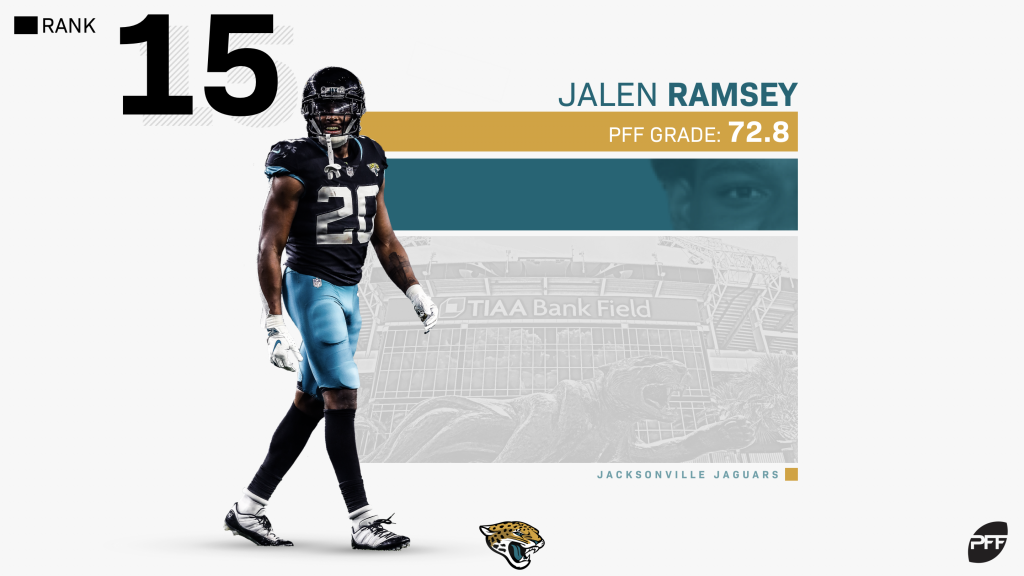
14. CB Stephon Gilmore, New England Patriots
Gilmore and Bill Belichick’s defensive scheme have been a match made in heaven. No qualifying cornerback has earned a higher coverage grade over the past two seasons than Gilmore at 91.9. Among the 56 cornerbacks with 800-plus coverage snaps played in the two-year span, Gilmore ranks fourth in completion percentage allowed (50.3%), second in forced incompletion percentage (26.7%) and 11th in passer rating allowed (73.2).
From PFF’s Austin Gayle on Gilmore’s career year in 2018:
“Gilmore’s 2018 season was also a historic effort. Among the 1,082 instances where a cornerback was targeted 50 or more times in a single season since 2006, Gilmore’s 2018 campaign ranks 12th in completion percentage allowed (44.0%). His 26.6% FINC percentage a year ago ranks seventh on the list – just shy of his 26.8% FINC percentage in 2017.
His 84.8 coverage grade in single coverage ranked third among cornerbacks with at least 20 targets in such coverage a year ago. Baltimore Ravens’ Marlon Humphrey (90.6) and Chicago Bears’ Kyler Fuller (90.0) were the only two corners ahead of Gilmore.”
13. T David Bakhtiari, Green Bay Packers
The highest-ranked offensive lineman on the 2019 PFF50 is none other than the league’s top pass protector, Green Bay Packers’ David Bakhtiari. Earning 93.0-plus pass-blocking grades in each of the past three seasons, Bakhtiari leads all offensive linemen with 1,200-plus pass-blocking snaps played since 2016 in pass-blocking grade (96.8). He also leads all offensive tackles on the list in pressure percentage allowed (3.4%) and pass-blocking efficiency (98.1).
Bakhtiari received PFF’s 2018 Pass Blocker of the Year Award for his efforts this past season. From PFF’s Mike Renner:
“Bakhtiari is currently the gold standard for pass protection in the NFL. There are better run blockers and more impressive athletes playing tackle today, but no one is stingier in pass protection than the Packers left tackle.”
12. WR Michael Thomas, New Orleans Saints
Only Julio Jones (94.3) has earned a higher receiving grade than Thomas (93.2) among the 82 NFL wide receivers with at 900 routes run over the past three seasons (2016-18). He also ranks third on the list in passer rating when targeted (116.8) and yards per route run (2.39), catching 352-of-448 targets for 4,210 yards, 202 first downs and 26 touchdowns in the process.
Thomas has also dropped just 2.76% of his 448 targets in his career, a rate that ranks third among the 59 wide receivers with at least 200 targets since 2016. Only Seattle Seahawks’ Doug Baldwin (2.46%) and Tyler Lockett (2.65%) have recorded lower drop rates in the three-year span.
11. Edge Von Miller, Denver Broncos
Miller has now earned a 90.0-plus overall grade every year of his eight-year NFL career, all while playing at least 540 defensive snaps each season. Also, his single-season pass-rush grades have never dipped below 85.6 (2014), and his lowest single-season run-defense grade in his career is 79.6 (2011).
Going into his age-30 season, Miller will fight against father time to keep his streak of single-season overall grades of 90.0 or higher in 2019, but he’s still given no reason to doubt his excellence at this point in his career.
10. WR Julio Jones, Atlanta Falcons
Riding the momentum of five consecutive years with single-season receiving grades of 89.0 or higher, Jones enters his age-30 season with unparalleled production at the NFL since 2014. He’s ranked first in yards per route run in four of the past five seasons, and his five-year yards per route run average (2.99) leads the position by a considerable margin.
From PFF’s Mark Chichester in January:
“Since he entered the league in 2011, Jones ranks second in receptions (698), second in receiving yards (10,731), third in receiving yards after the catch (3747), second in first down receptions (495) and first in explosive plays (302) among receivers in that span. This is all while grading among the top-five players at the position in each year since 2014, including a three-season run from 2015 to 2017 where he finished as the highest-graded receiver in football.
In yet another elite-caliber season, Jones ended the 2018 campaign with 113 catches for 1677 receiving yards from 573 snaps in route. His average of 2.93 yards per route run ranked first among receivers with at least 200 routes run, and it’s also fifth-highest mark since 2014, with the only player/seasons ahead of him being Julio Jones in 2016, Julio Jones in 2017, Julio Jones in 2015 and A.J. Green in 2014.”
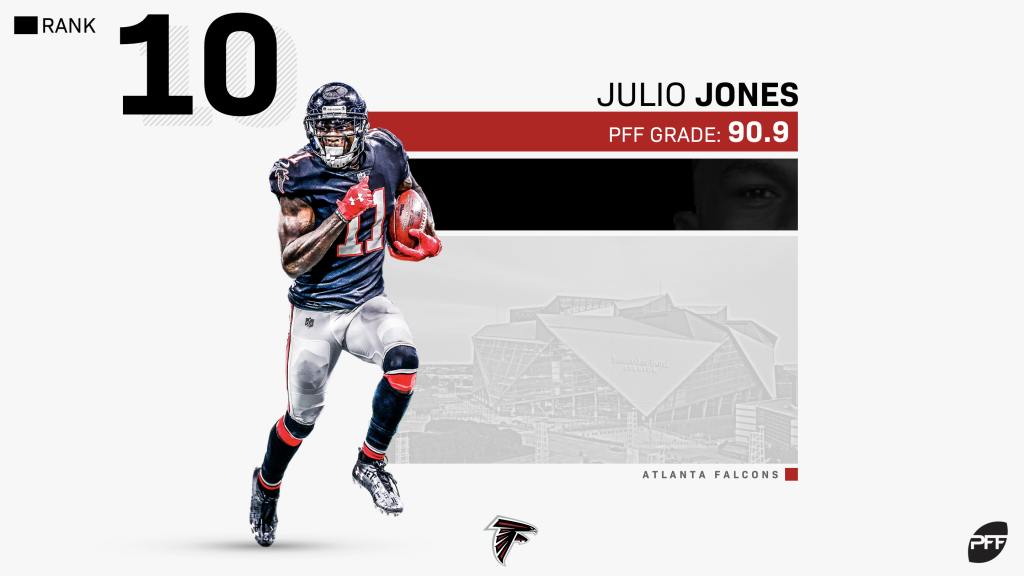
9. WR DeAndre Hopkins, Houston Texans
It’s a two-man race between Jones and Hopkins for top NFL receiver entering the 2019 season, and we at PFF have opted for the latter. Hopkins’ two-year receiving grades bests that of Jones by 0.2 grade points, and Hopkins also finished ahead of Jones in PFF’s new WAR metric (3.24) and receiving grade (92.1) in 2018. The 27-year-old Texans standout is only getting started.
From PFF’s Mike Renner in his article crowning the Texans wideout as the 2018 PFF Offensive Player of the Year:
“There’s really nothing Hopkins can’t do as a wide receiver. He ranked top-10 in touchdowns (11), deep receiving yards (387) and broken tackles (12). Hopkins was everything and then some in his first full season with Watson at the helm. Still only 26 years old, Hopkins is going to be putting up big numbers for a long time in Houston.”
8. Edge Khalil Mack, Chicago Bears
Mack’s transition from Oakland to Chicago went swimmingly. He kept his streak of 90.0-plus graded seasons alive in the Windy City, earning a 90.7 overall grade, 87.4 run-defense grade and an 86.0 pass-rush grade in his first year with the Bears. He’s also recorded 70 or more pressures in four consecutive seasons while logging pass-rush win rates above 15% every single year. Entering his age-28 season and Year 2 with the Bears, Mack is the NFL’s top edge defender in the game right now.
7. LB Luke Kuechly, Carolina Panthers
Kuechly has earned 90.0-plus overall grades in each of the past five seasons, all while earning 85.0-plus coverage grades each year. He and Bobby Wagner share the NFL lead among off-ball linebackers in forced incompletions (32) since 2014, but it’s Kuechly that owns the sole lead in coverage stops (129) in the five-year span.
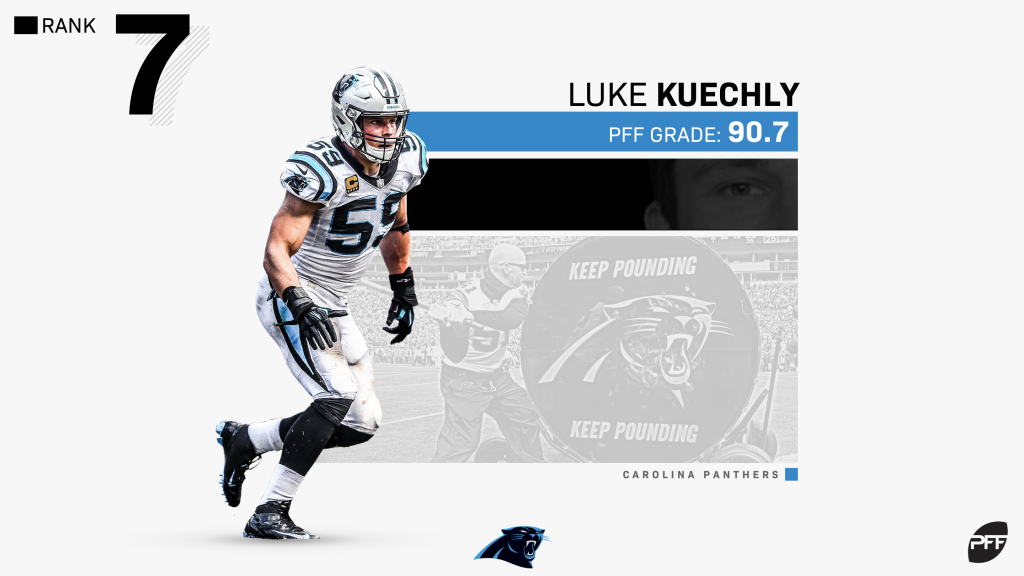
6. QB Patrick Mahomes, Kansas City Chiefs
Mahomes’ 46 big-time throws were three more than anyone else in the NFL. He broke PFF’s single-season deep passing yardage record with 1,514 yards on passes of 20 or more yards downfield, and that’s with three dropped deep balls on the year. In fact, Mahomes had 35 dropped passes from his receivers this season, the third-most of any quarterback in the NFL.
Named PFF’s 2018 MVP, Mahomes is no flash in the pan. PFF’s Mike Renner sees the Kansas City signal-caller continuing to dominate the NFL far beyond the 2019 season.
“The superlatives for the second-year quarterback go on and on. In only his second year in the NFL, he’s already the league’s most valuable player. While the season didn’t end the way he or Chiefs fans had hoped, the rest of the NFL should be scared for seasons to come.”
5. QB Drew Brees, New Orleans Saints
On his 489 regular season attempts, Brees’ ball placement was deemed to be ‘perfect’ 20.0% of the time and ‘accurate’ 71.5% of the time, which ranked sixth and first among the league’s quarterbacks this year, respectively. Among the 44 quarterbacks with at least 100 dropbacks throughout the regular season, Brees’ positively-graded throw rate of 27.6% ranked fourth, while his absurdly low negatively-graded throw rate of 7.0% was far and away the best mark in the league.
Brees took home PFF’s 2018 top passer award following what was a record-setting season for the veteran signal-caller this past season.
From PFF’s Mark Chichester:
“When you add it all up, Brees was the clear top passing quarterback in the league, and it showed in his PFF passing grade, the only one above 93.0 in the NFL this season. In his 18th year, Brees has continued to demonstrate that he can produce on any field he steps foot on, and he has continued to demonstrate the traits that arguably make him the most accurate quarterback of all time. After an incredible, record-breaking season, his performance throughout the season is more than deserving of the award.”
4. DI Fletcher Cox, Philadelphia Eagles
It’s a shame that Cox plays in the same league as Donald; he’d be the unanimous decision for top defensive interior if it weren’t for the Rams superstar. Cox’s pass-rush win rate in 2018 (20.9%) is the fourth-best single-season mark of any defensive interior in the PFF era. And his 91.2 pass-rush grade this past season, another career-high for the big man, also ranks inside the top 10 among qualifiers since 2006.
From PFF’s Austin Gayle in his latest feature on Cox comparing him and Donald:
“Among the 125 interior defensive linemen with 500 or more pass-rush snaps since 2015, Donald ranks first in pass-rush grade (95.9), total pressures (375) and pass-rush win percentage (22.1%). Cox ranks second behind Donald in all three metrics.
And the trend continues, as Donald led all at his position in pass-rush grade in each of the past four seasons (2015-18). Cox ranked second two of the years (2017 & 2018) and third in another (2015).”
3. LB Bobby Wagner, Seattle Seahawks
Wagner finished the year ranked first in overall grade (91.9), coverage grade (90.4) and run-defense grade (91.8) among qualifying off-ball linebackers in 2018. Only two off-ball linebackers in the PFF era (2006-18) have earned 90.0-plus marks in all three facets: Wagner in 2018 and Kuechly in 2015. Wagner also missed just one tackle across 140 attempts this past season.
Though Kuechly isn’t too far off the Seahawks phenom, Wagner takes the cake for top off-ball linebacker in the NFL right now coming off one of the best seasons we’ve ever seen at the position.
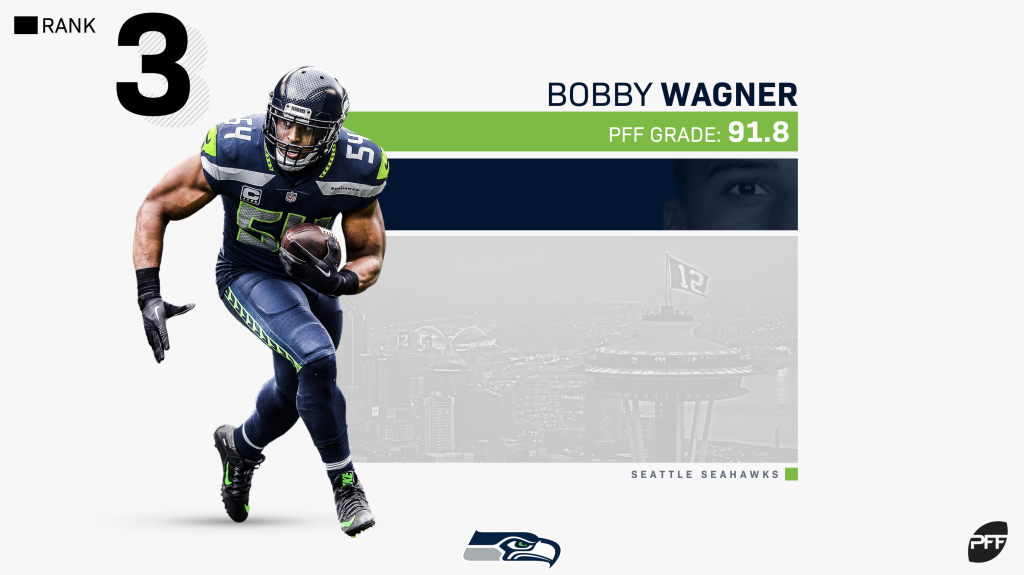
2. QB Tom Brady, New England Patriots
Yes, he’s still the best in the business.
Even at 41 years old, Brady turned in an elite 90.6 overall grade in 2018, making it the fourth consecutive season he’s earned an overall grade of 90.0-plus. His passing grade on passes with a step of separation over the last three years leads all qualifying signal-callers, and his passing grade on tight-window throws ranks fourth on the list. Surprising no one, Brady also earned a starting role on PFF’s 2018 NFL Clutch Team for his efforts in one-score games this past season.
From PFF’s Ben Linsey in his 2018 NFL Clutch Team article:
“We kick off the list with a shocker. Tom Brady has been the standard at the quarterback position for the better part of his career, and in a year in which he took home his sixth Super Bowl title, Brady earns a first-team spot on the Clutch Team with his 90.5 grade when it mattered most. He picked up big chunks late in tight games — 1,073 passing yards on 107 attempts — and those 10.0 yards per attempt led all quarterbacks with 50 or more attempts in clutch time.”
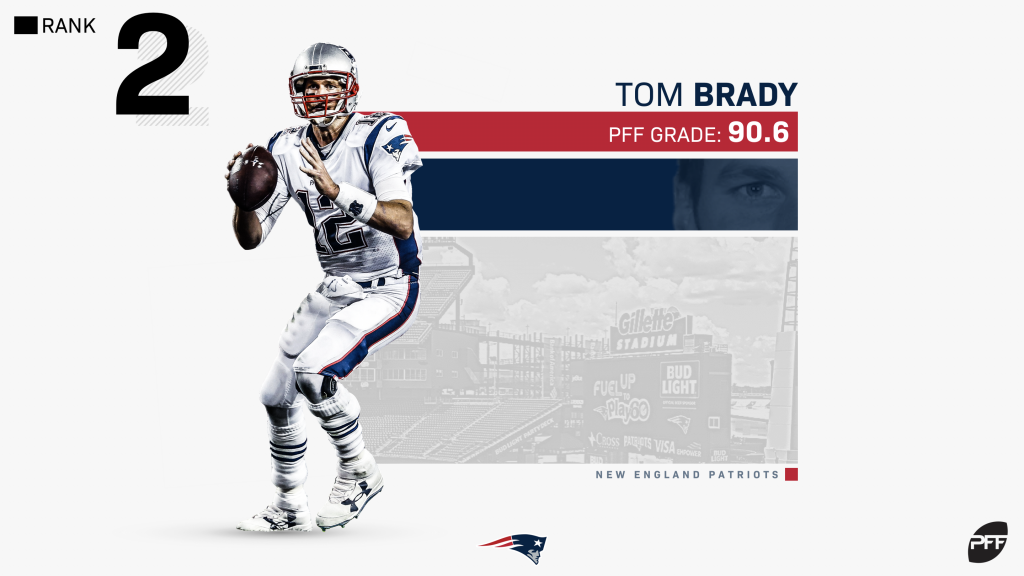
1. DI Aaron Donald, Los Angeles Rams
Donald has single-handedly rewritten the PFF record books. He’s led his position in overall grade and pass-rush grade in every year after his rookie campaign in 2014. And he still ranked second in overall grade and third pass-rush grade as a first-year player five years ago. Four of the five best single-season pass-rush win rates in the PFF era (2006-18) belong to Donald.
From PFF’s Austin Gayle:
“We ran out of superlatives for Donald after last season, and now we’re running out of records. He’s now won PFF’s Defensive Player of the Year in three of the last four years – soon enough we’ll run out of awards, too.”
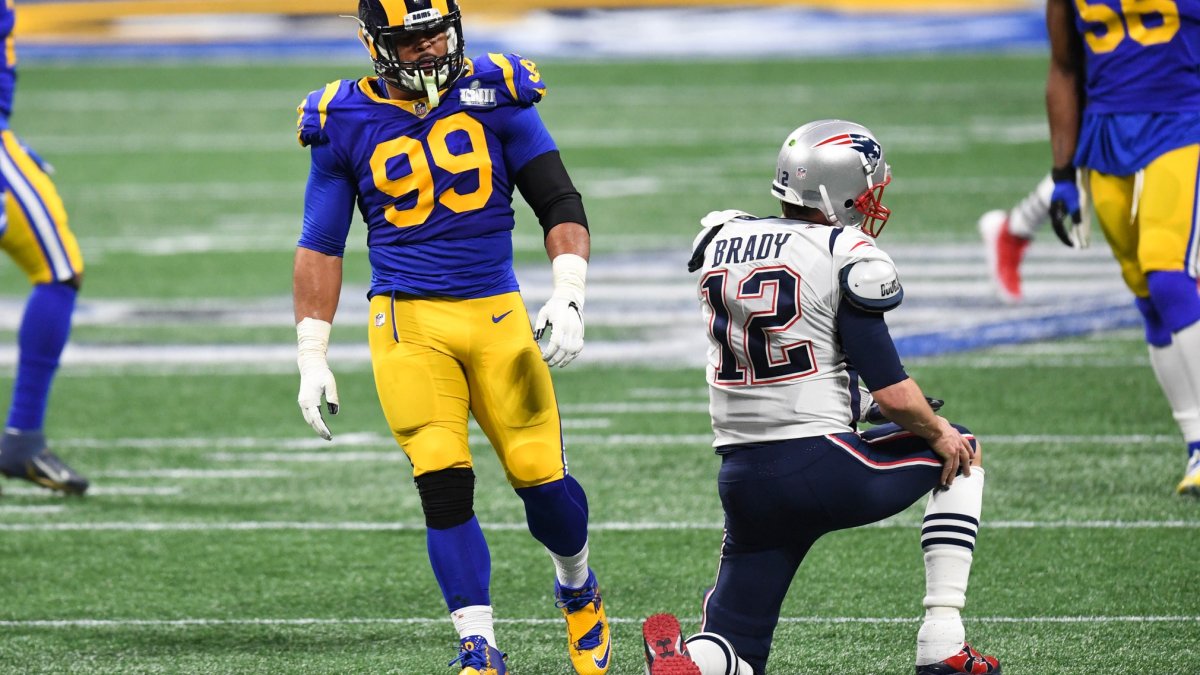

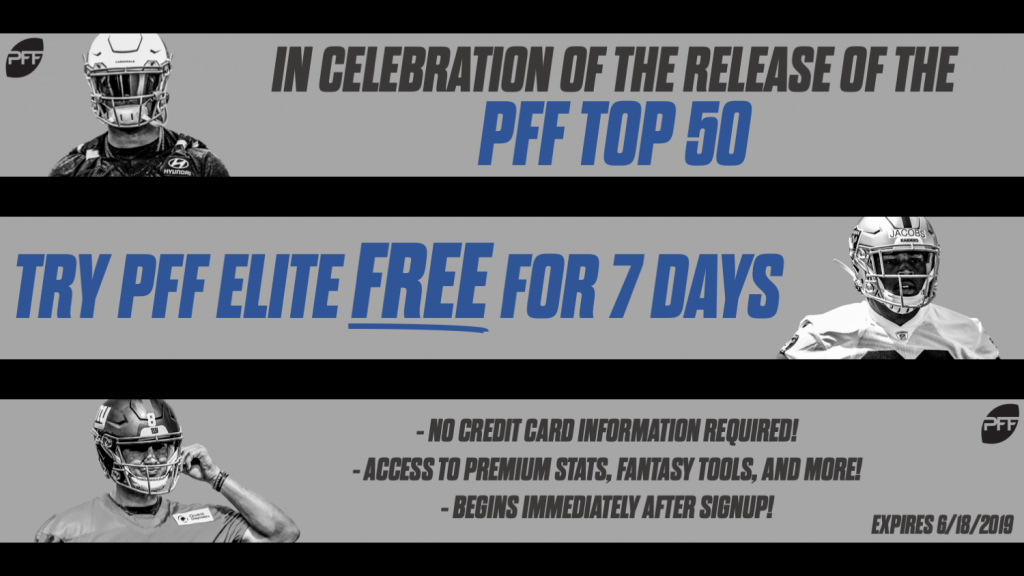


 © 2025 PFF - all rights reserved.
© 2025 PFF - all rights reserved.